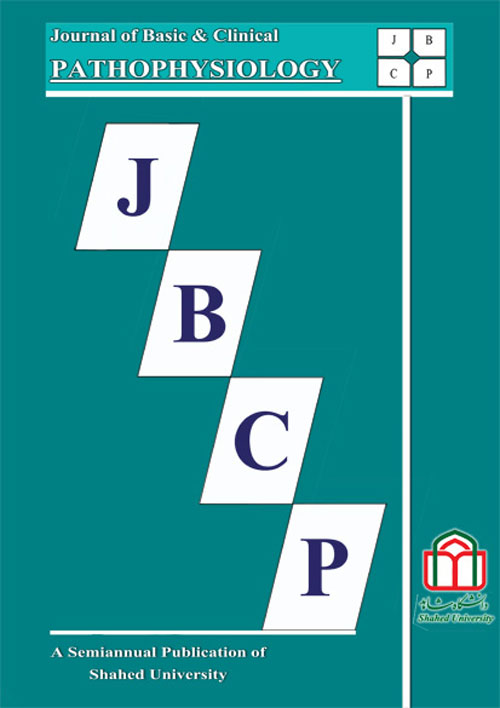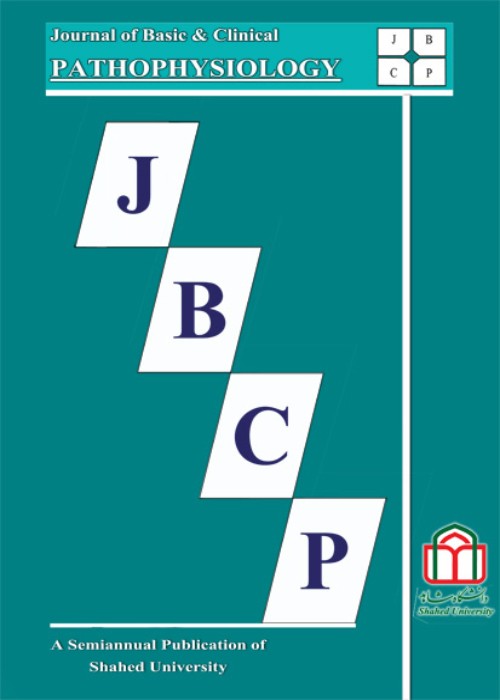فهرست مطالب

Journal of Basic & Clinical Pathophysiology
Volume:4 Issue: 1, Winter-Spring 2016
- تاریخ انتشار: 1395/02/08
- تعداد عناوین: 7
-
-
Pages 1-6Background And ObjectiveConsidering the wide side effects of synthetic pain killers, use of herbal drugs in folk medicine as analgesic agents has increased. In the present work, we tried to uncover the pharmacological potential of ethanolic extracts by using various animal models and also to explore the potent antinociceptive effect of the plant Thymus kotschyanus.Materials And MethodsThe ethanolic extract from the aerial part of Thymus kotschyanus after intraperitoneal administration at doses of 50, 100 and 200 mg/kg was evaluated against pain using formalin test and tail flick test.ResultsThymus kotschyanus extract at doses of 100 mg/kg (pConclusionThe results obtained in this study highlight that aerial part extract of Thymus kotschyanus possesses analgesic properties in both acute and chronic inflammatory pain.Keywords: Thymus kotschyanus Analgesic Formalin test Tail flick test Pain
-
Pages 7-12Background And ObjectiveSeveral studies have found that diazepam decreases serum glucose. Meanwhile, glibenclamide is commonly used in diabetes treatment. The objective of this study was to survey the treatment impact of diazepam and glibenclamide on blood glucose and serum lipids in mice with type II diabetes.Materials And MethodsIn this study, 32 male rats were divided into four groups, i.e. diabetes, glibenclamide, diazepam and combination of glibenclamide and diazepam. Diabetes was inducted using 60 mg/kg of streptozocin injection at single dosage. Medicinal dosage was 0.285 mg/kg for glibenclamide and was 1 mg/kg for diazepam and 50 percent of above mentioned dosages for complex therapeutic dosage. Treatment was continued for 16 days after positivity of diabetes. The level of blood glucose in serum and lipid profile of the rats were surveyed at the end of the study.ResultsTherapeutic combination of diazepam and glibenclamide caused a significant reduction of serum glucose in comparison with control group at 9 and 16 days (pConclusionThe combined treatment of glibenclamide and diazepam caused the improvement in controlling the serum glucose and can appropriately change the level of serum HDL in diabetic rats.Keywords: Type II Diabetes Diazepam Glibenclamide
-
Pages 13-18Background And ObjectiveChronic diabetes mellitus (DM) leads to cardiovascular dysfunction. Diosgenin is a natural steroidal saponin with cardiovascular protective potential. In this research study, the beneficial effect of diosgenin was evaluated on some markers of oxidative stress in cardia tissue of streptozotocin (STZ)-diabetic rats.Materials And MethodsMale Wistar rats (n = 28) were divided into equal-sized control, diosgenin-treated control, diabetic, and diosgenin-treated diabetic groups. Diabetes was induced by a single intraperitoneal injection of streptozotocin (60 mg/kg). Diosgenin was administered p.o. at a dose of 40 mg/kg for 7 weeks. Some markers of oxidative stress including malondialdehyde (MDA), superoxide dismutase (SOD), catalase, and reduced glutathione (GSH) were measured in cardiac tissue homogenate.ResultsIt was found out that diabetic group had an elevated MDA content (pConclusionDiosgenin could attenuate cardiac lipid peroxidation and improves non-enzymatic antioxidant defensive system in diabetic condition and it may be considered as a potential therapeutic agent to mitigate cardiac dysfunction in DM.Keywords: Diosgenin Diabetes mellitus Streptozotocin Heart Oxidative stress Antioxidant
-
Pages 19-22Background And ObjectivesPrevious studies have shown the antinociceptive effect of morphine in animal models, but the specific anti-pain consequence of the abuse drug in female animals is unclear. The present research showed the morphine antinociception in female Wistar rats using formalin test.Materials And MethodsSubjects were 40 female Wistar rats purchased from Pasteur Institute of Iran. They were treated intraperitoneally (i.p.) with morphine (3-12 mg/kg) 10 min before of the formalin test. In order to induce the chemical pain, the rats received intraplantar injection of formalin (2.5% / 50 μL) and given the test. The control rats received saline solution (1 mL/kg, i.p.) instead of the morphine. The nociceptive response was divided into two phases: phase acute (0-15 min) and phase chronic (15-60 min). The animals were graded by a 4-point scale each 15 sec continuously throughout the test.ResultsThis study revealed the morphine-induced antinociception at the early as well as the late phases of the formalin test. Moreover, the response to the lower doses of morphine in the early phase was considerable in comparison to the late phase.ConclusionThe data indicate a definite morphine antinociception role in female Wistar rats. The female rats may exhibit less anti-pain effect of morphine in the late phase of the chemical pain unless if receiving the effective doses of the drug.Keywords: Morphine Analgesia Formalin test Rat
-
Pages 23-26Background And ObjectiveParkinson's disease (PD) is a neurodegenerative disease with selective damage of mesencephalic dopaminergic neurons. Due to the protective, anti-inflammatory, and antioxidant effect of Hypericum perforatum (HP), this study was undertaken to assess dose-dependent effect of HP hydroalcoholic extract on motor imbalance following intrastriatal injection of 6-hydroxydopamine in the rat.Materials And MethodsIn this experimental research, male Wistar rats (n=35) were equally divided into sham, 6-hydroxydopamine (OHDA)-lesioned, and HP extract-treated lesion groups. Model of PD was induced by microinjecting 12.5 microgram of 6-OHDA dissolved in saline-ascorbate solution into the left striatum. Treated lesion groups received HP extract at doses of 50, 100, and 200 mg/kg/day p.o. started one week before the surgery for 1 week post-surgery. After 1 week, ipsilateral and contralateral rotations induced by apomorphine were counted and net scores were obtained.ResultsIn the 6-OHDA-lesioned group, the dopaminergic agonist apomorphine induced contralateral rotational behavior (PConclusionOral administration of HP extract at doses of 100 and 200 mg/kg could reduce motor imbalance and attenuate forced biased rotational behavior in 6-OHDA-induced model of PD.Keywords: Hypericum perforatum 6, hydroxydopamine Rotational behavior Motor imbalance Dose, dependent
-
Pages 27-34Background And ObjectiveIn neurodegenerative disorders, oxidative stress mediated by reactive oxygen species is strongly associated with increased neuronal damages that lead to apoptosis. Pro-apoptotic and anti-apoptotic gene expressions were changed during cell differentiation that affect cell viability and differentiation. This study was conducted to determine the effects of hydrogen peroxide-induced oxidative stress on apoptotic cell death in the differentiated rat pheochromocytoma (PC12) cells.Materials And MethodsSemi-differentiated PC12 cells were treated with 400 µM hydrogen peroxide. Characteristic morphological changes as anapoptotic index were evaluated by DAPI staining. MTT assay were used to evaluate cells survival and activity. Pro-apoptotic and anti-apoptotic gene expression were estimated by real time-PCR.ResultsThe obtained data indicate that PC12 cell survival rate decreases in H2O2-treated condition during differentiation. Also, H2O2 increases apoptotic genes expressions including caspase 6 and PIN1 and decreases anti-apoptotic genes including sirt1 and sirt7.ConclusionH2O2-induced oxidative stress can retard the differentiation of PC12 cell to neural-like cells through the apoptotic gene expression. On the other hand, despite the PIN1 acts as an apoptotic gene, this study illustrated that the expression of this gene is increased during differentiation under oxidative stress conditions.Keywords: Differentiation PC12 PIN 1 Caspase 6 Sirt 1 Sirt 7 Apoptosis
-
Pages 35-40Background And ObjectiveParkinsons disease (PD) is a common neurological disorder due to degeneration of dopaminergic neurons within pars compacta of substantia nigra (SNC). With regard to protective effect of Malva sylvestris (MS), this study was conducted to evaluate the effect of aquaeous extract of this plant in an experimental model of PD induced by 6-hydroxydopamine (6-OHDA).Materials And MethodsRats were divided into sham-operated, MS-treated sham-operated, lesioned and MS-treated lesioned groups. The hemi-PD early model was induced by unilateral intrastriatal injection of 6-OHDA (12.5 µg/5µl of saline-ascorbate, left side). The treated groups received aquaeous extract of MS (i.p.) at a dose of 100 mg/kg once a day for one week at an interval of 24 h till 1 h pre-surgery. One week after surgery, the animals were tested for rotational behavior by apomorphine for an hour and the number of dopaminergic neurons in the SNC was counted.ResultsAfter one week, apomorphine caused a significant contralateral turning (PConclusionIntraperitoneal administration of aquaeous extract of Malva sylvestris could reduce motor asymmetry and has not neuroprotective effect against 6-OHDA toxicity in an experimental model of PD.Keywords: Malva sylvestris Parkinson's disease 6, hydroxydopamine Motor asymmetry Dopaminergic neurons


